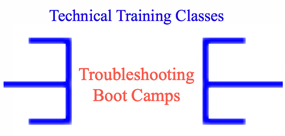|

Troubleshooting Boot Camps
presents
ArcSafe Certification On-Site Training
The foremost goal of this three-day Arc Flash Electrical Safety course is to keep workers safe while working on or around electrically energized equipment.
Course Description/Agenda
The foremost goal of this two-day Arc Flash Electrical Safety
course is to keep workers safe while working on or around
electrically energized equipment. The course is structured to help
companies fulfill requirements set forth in OSHA 29 CFR Part 1910,
Subpart S Electrical and NFPA 70E® "Standard for Electrical Safety
in the Workplace", which requires this type of instructor-led
training for anyone working with electrically energized equipment.
Overall, this program is designed to reduce liability for the
employer while establishing a culture of safe work practices among
employees; it is a key component of any electrical training
program.
Course Topics & Objectives (Days One & Two)/h3>
Electrical Safety & the Qualified Person (Electrical Worker)
- Code and Standards: OSHA, NFPA 70E, NEC, ANSI, IEEE and others
- Notable Changes to NFPA 70E 2018
- Qualified Person Requirements
- Contractor Safety Requirements
- Unqualified Person Requirements
Electrical Hazards & Injuries
- Electrical Incident Overview
- Shock Hazards
- Arc Flash & Arc Blast Hazards
- Electrical Fires
- Electrical Burns
- Static Electricity
- First Responder/Emergency Response for Electrical Incidents
- Identifying Electrical Hazards:
- Design & Installation Problems
- Work Procedure Problems
Safety Related Work Practices
- Elements of an Electrical Safety Program
- Job Planning
- Work on or near Energized Parts
- Boundaries and Safe Approach Distances:
- Shock Hazards
- Arc Flash Hazards
- Overhead Lines
- Motor Vehicles
- Six Steps to Establishing a Safe Work Condition
- Lockout/Tagout
- Temporary Grounding Overview
- Operating Circuit Breakers
- Energized Work Permit
- Housekeeping
Electrical Equipment & Tools
- Test Equipment Safety & Care
- Power Tool Equipment Safety & Care
- Hand Tool Equipment Safety & Care
- Extension Cords & Temporary Wiring
- Portable Ladders
Arc Flash Safety Practices
- Arc Flash & Arc Blast Overview
- Incident Energy & PPE
- Interpreting Arc Flash Data
- Arc Flash Boundaries
- Hazard/Risk Categories
- Identifying Proper PPE for Arc Flash and
- Shock Hazards
- Reading and Using Arc Flash Labels & NFPA 70E Table
130.7(C) (15) (A)
Personal Protective Equipment (PPE) for Electrical Safety
- Understanding PPE for Electrical Safety:
- Clothing & Apparel
- Tools
- Barricades, Signs & Attendants
- Other Protective Devices
- Proper Care of PPE
- Testing Requirement of Electrical Safety
PPE Electrical Preventative Maintenance for Safety
- Role of Electrical Preventive Maintenance for Electrical
Safety
- General Maintenance Requirements
- Electrical Studies — Short Circuit, Protective Device
Coordination and others
- Electrical Testing
- GFCI
- Infrared (IR)
- Circuit Breakers
- Relays
- Transformer Oil
Performing Risk Assessments & Job Planning
- Performing Risk Assessments
- Performing Job Briefings
Reading & Applying Arc & Shock Hazard Data
- Using NFPA Tables and Arc Flash Labels
- Review and Understanding Arc Flash Calculations
- Identify Shock Hazards and Arc Flash Hazards
Application of PPE & Boundaries
- Select Appropriate PPE
- Establish Proper Boundaries & Notifications
- Demonstrate Appropriate use of PPE
Creating an Electrically Safe Work Environment
- Demonstrate Appropriate Safe Work Safety Practices within
Boundaries
- Selecting and Using Meters
- Lockout Process
Course Topics & Objectives (Day Three)
- Verify De-energized State with Electrical Meter
- Test Real Live Electrical Disconnect in the Classroom
- Perform Lockout/Tagout Procedure in the Classroom
- Fit, Test, and Inspect Electrical PPE
- Test Flexible Cords for Correct Functionality using Electrical Meter
- Discuss Real-Life Incident Case Studies
- Determine the Minimum Hazard Risk Category for Specific Equipment
- Select the Appropriate Electrical Meter
- Review and Understand a Short Circuit Calculation Example
- Use Tables NFPA 70E® 130.7(C)(15)(a) and 130.7(C)(16) Accurately
- Complete an Energized Electrical Work Permit
- Perform a Job Briefing
- Complete a Hazard Risk Assessment
- Complete a blank Arc Flash Label
- Determine the Limited, Restricted and Arc Flash Boundaries
- Review and Take the ArcSafe Certification Exam
STUDENTS ARE REQUIRED TO SCORE 80% ON FINAL TEST TO PASS THE COURSE
Who Should Attend
-
Energy management personnel
-
Apprentice and experienced HVAC technicians
-
IT Technicians
-
Fire Alarm Technicians
-
Electricians
-
Multi-craft personnel
-
Plant & facility maintenance technicians
-
Building engineers
-
Building managers & superintendents
-
Plant & facility managers
-
Stationary engineers
-
Anyone who works with electrical systems and circuits
Requirements
Students should have a basic knowledge of basic electrical
theory.
|
 Add to favorites
Add to favorites Email this page
Email this page

 On-Site Training
On-Site Training Seminar
Seminar